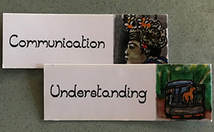|
Presentations make for a competitive challenge. We prepare them, watch them and try to remember them. So, what makes one stand out? The use of simple, strong, clear, relatable language and images that connect with audiences. All these are key components of plain language. Here are ideas on how to increase the use of clear visuals and the impact of your next presentation. Integrating plain language guidelinesMarketingmag.com.au points out the weaknesses of presentations junky with charts, jargon and top heavy with text. Plain language guidelines can solve all these challenges. If you commit to clear language, concise messages and simple images that support your ideas, people will relate better and remember longer. Integrate plain language guidelines for your content and visuals to make your presentation memorable. Inspiring audiencesPresentation software is no longer exclusive. And, audiences come with high expectations. How can you meet them? In her article, ‘Choosing the right visuals’, Emma Bannister quotes research showing that 90% of what our brain processes is visual. A picture really can be worth a thousand words. The clear communication rules of simplicity apply here too. Rule 1: make sure the visual supports the text. Rule 2: design and present visuals that are audience-friendly. Rule 3: use real settings, people and locations whenever you can. Always ask, and preferably to a test audience, what viewers think of the content, the visuals, the presentation. Put people first and you’ll experience presentation power. After all, it is them we have to inspire. Impressions that lastPresenters can use clear design and presentation guidelines to enhance engagement. Gov.uk demonstrates how they committed to using simple slides to achieve memorable presentations. Choose a presentation style that supports clear information and visuals, and stick to it. Consistency in visuals is another way to have an impact.
Making an outstanding presentation relies on clarity, simplicity and strong visual impact. Set plain language guidelines, involve a test audience for feedback and be prepared to make changes to meet their needs. If you can confidently say you kept it simple, clear and really connected with visuals, you are heading for presentation success with some help from plain language guidelines. Want to learn more, take a PlainLanguageAcademy.com course. Editors Canada Conference 2018, May 25-27, Saskatoon: Plain Language Stream
0 Comments
 When Frances McDormand said the words “inclusion rider”, during her Academy Awards Best Actress Oscar acceptance speech, it meant so much more than the two words themselves. Plain language is most often practiced around the written word, presented on paper or online. But, when you mix in speaker, setting, audience and context, words can take on a much more dynamic meaning. Defining "inclusion rider" Not everyone would have a clear understanding of the legal implications of the words “inclusion rider”, but would use their familiarity with each term individually. McDormand herself is reported to have only recently become familiar with this contract option. But, in their legal sense, in the acting profession, here is how Wikipedia defines them: “An inclusion rider or equity rider is a provision added to a contract of an actor to ensure that casting and production staff are more representative and meet a certain level of diversity…” When a production company agrees to this rider, but doesn’t meet it, consequences can result. So, you take two plain words, mix in a legal connotation, and their meaning and impact can greatly change. Plain speaking and presentation impacts Inclusion researcher Dr. Stacy Smith presented data outlining the film industry’s inequalities in a TED Talk, highlighting the point that A-listers (top actors) can lead change with inclusion riders. That’s one group McDormand was addressing in her Oscar speech. But, the impact of those two words were super-enhanced by three environmental conditions because McDormand had:
Combine plain language and clear design On paper and online, we often don’t have that kind of influence. So, plain language is all the more important to get our messages across with the intended meaning, to the intended audience, generating the intended outcome. The next time you write content for a document, website or speech, consider the impact using plain language can have, especially if it is supported by clear visuals. The combined effect of plain language and clear design can be memorable. That's what we want in our communication. PlainLanguageAcademy.com 2018 course line-up. Register now. Clear Design and Plain Language Basics begin April 1. Advanced: Editing for Plainer Legal Writing begins April 10. |
Let's stay connected.Subscribe to our blog for Plain Language Academy news, tips and updates. Categories
All
Archives
September 2023
|
Choose your Academy. Choose your courses. We are here to work with you.
www.facebook.com/plainlanguageacademy Twitter #plainlanguageacademy


 RSS Feed
RSS Feed